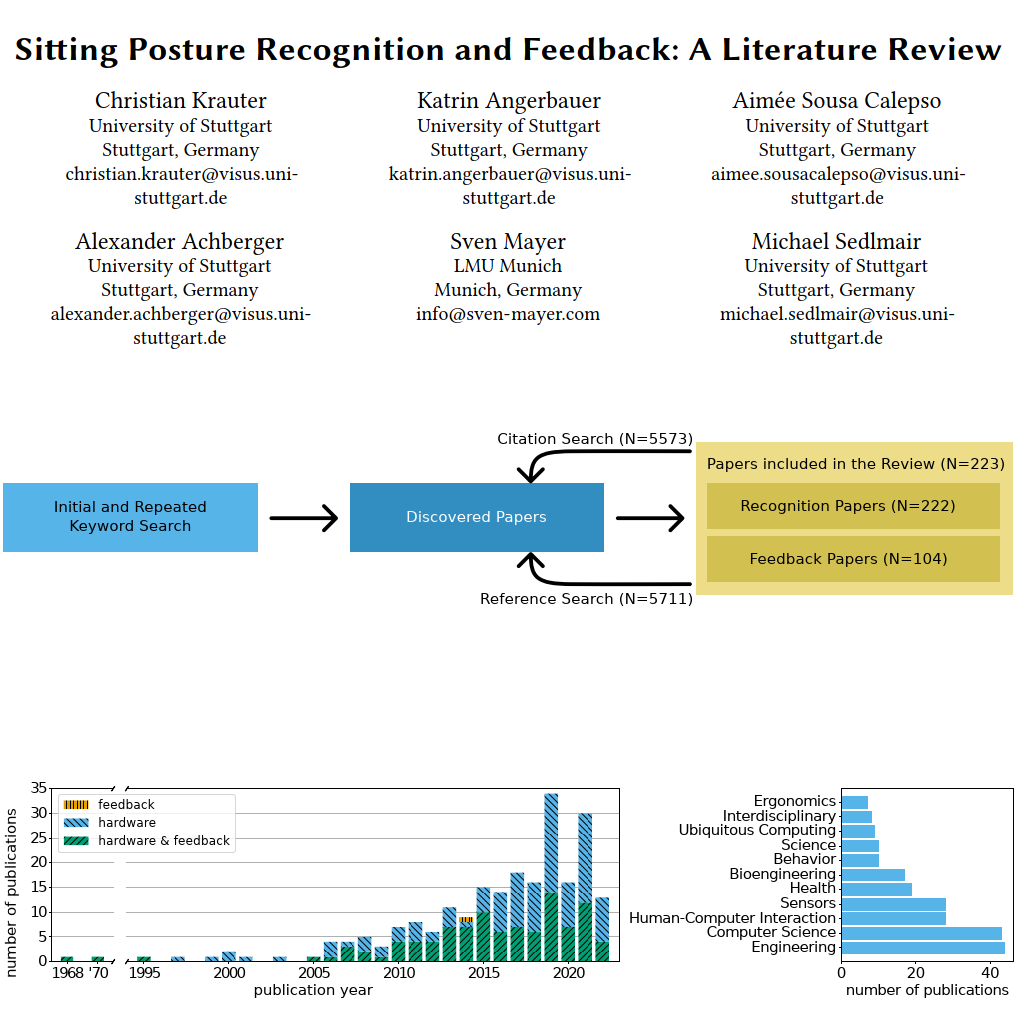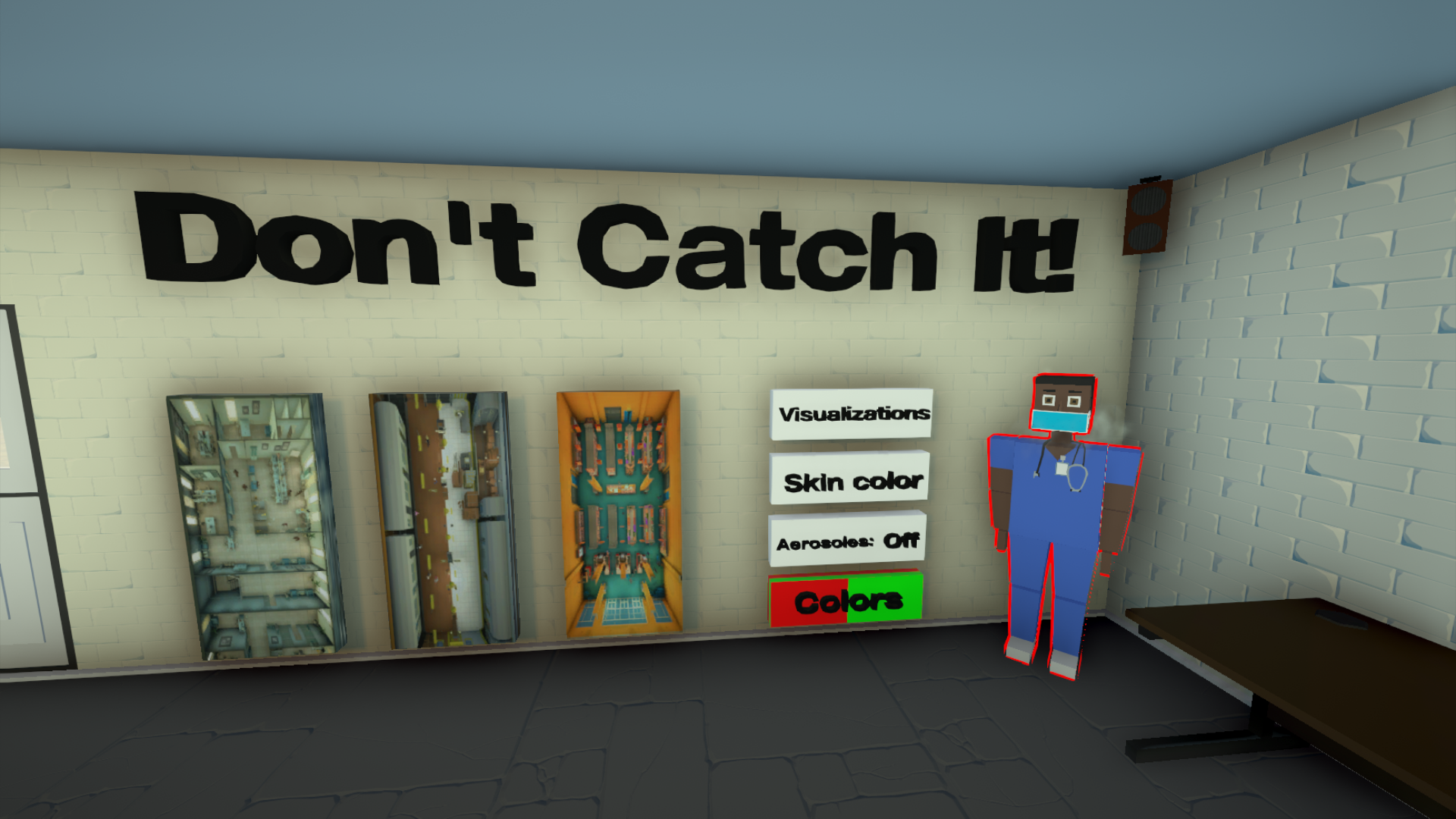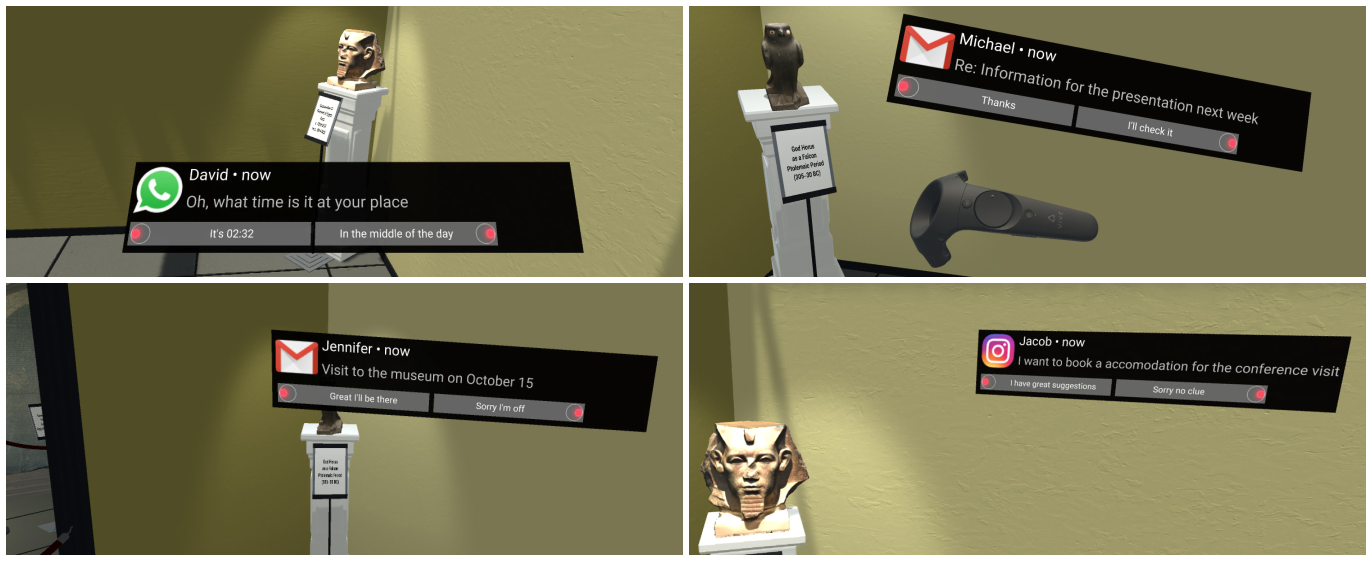publications
2025
-
 Perception Thresholds for Unobtrusive Movement in VR Versus ARVerena Biener, Metin Arab, Christian Krauter, and Dieter SchmalstiegIn Int. Symp. Mixed and Augmented Reality Adjunct (ISMAR-Adjunct), 2025
Perception Thresholds for Unobtrusive Movement in VR Versus ARVerena Biener, Metin Arab, Christian Krauter, and Dieter SchmalstiegIn Int. Symp. Mixed and Augmented Reality Adjunct (ISMAR-Adjunct), 2025Over the last years, extended reality (XR) has been actively promoted as a tool for productivity or office tasks instead of purely for entertainment. Unfortunately, technical limitations of head-mounted XR devices could cause additional ergonomic problems to the ones that office workers already face, such as back pain caused by prolonged sitting. A possible countermeasure that XR offers is to adjust the workplace by placing virtual screens anywhere without physical restrictions. Previous work has also proposed to subtly move screens in VR to induce movement and active sitting in the users without distracting them from their tasks. We replicate a study on perception thresholds for such subtle movement in VR and extend it to AR. Our results mostly confirm those previously documented in VR and that similar effects can be observed in AR.
@inproceedings{Biener2025Perception, author = {Biener, Verena and Arab, Metin and Krauter, Christian and Schmalstieg, Dieter}, booktitle = {Int. Symp. Mixed and Augmented Reality Adjunct (ISMAR-Adjunct)}, title = {Perception Thresholds for Unobtrusive Movement in VR Versus AR}, publisher = {IEEE}, year = {2025}, month = oct, pages = {340-345}, doi = {10.1109/ISMAR-Adjunct68609.2025.00072}, } -
 Demonstration of VisRing: A Display-Extended Smartring for Nano VisualizationsLiu Runze*, Christian Krauter*, Taiting Lu, Mara Schulte, Alexander Achberger, Tanja Blascheck, Michael Sedlmair, and Mahanth Gowda
Demonstration of VisRing: A Display-Extended Smartring for Nano VisualizationsLiu Runze*, Christian Krauter*, Taiting Lu, Mara Schulte, Alexander Achberger, Tanja Blascheck, Michael Sedlmair, and Mahanth Gowda
* contributed equallyIn Adjunct Proc. Symp. User Interface Software and Technology, 2025We demonstrate VisRing, the first smartring incorporating a bendable 160 x 32 4-bit grayscale organic light-emitting diode display. VisRing stands out by displaying nano visualizations while maintaining a compact design and minimal weight of 6.6 g, with an overall cost of around $35. We exploit opportunities for a system-on-a-chip architecture to tightly integrate an inertial measurement unit, a photoplethysmograph sensor, a temperature sensor, Bluetooth, a microcontroller, and a display unit that spans 270° to 360°, depending on finger size. Our contributions include the hardware design and implementation of VisRing, along with a software library that supports visualizing various data types. A qualitative study with 12 participants demonstrated the comfort, likability, and social acceptance of VisRing’s hardware and software. The participants liked the visualizations and found the ring lightweight, but also pointed out possible improvements. We will open-source VisRing hardware and software for further development of interesting usage scenarios. The demo will include a showcase of the VisRing system hardware assembly and hands-on and live testing of various VisRing applications, which include message delivery, time display, and health monitoring.
@inproceedings{LuKrauter2025DemoVisring, title = {Demonstration of VisRing: A Display-Extended Smartring for Nano Visualizations}, author = {Runze, Liu and Krauter, Christian and Lu, Taiting and Schulte, Mara and Achberger, Alexander and Blascheck, Tanja and Sedlmair, Michael and Gowda, Mahanth}, year = {2025}, month = sep, booktitle = {Adjunct Proc. Symp. User Interface Software and Technology}, series = {UIST Adjunct}, publisher = {ACM}, doi = {10.1145/3746058.3758997}, articleno = {32}, numpages = {4}, url = {https://github.com/ChristianKrauter/VisRing}, url2 = {https://github.com/TaitingLu/VisRing} } -
 VisRing: A Display-Extended Smartring for Nano VisualizationsTaiting Lu*, Christian Krauter*, Runze Liu, Mara Schulte, Alexander Achberger, Tanja Blascheck, Michael Sedlmair, and Mahanth Gowda
VisRing: A Display-Extended Smartring for Nano VisualizationsTaiting Lu*, Christian Krauter*, Runze Liu, Mara Schulte, Alexander Achberger, Tanja Blascheck, Michael Sedlmair, and Mahanth Gowda
* contributed equallyIn Proc. Symp. User Interface Software and Technology, 2025We introduce VisRing, the first smartring incorporating a bendable 160 x 32 4-bit grayscale organic light-emitting diode display. VisRing stands out by displaying nano visualizations while maintaining a compact design and minimal weight of 6.6 g, with an overall cost of around $35. We exploit opportunities for a system-on-a-chip architecture to tightly integrate an inertial measurement unit, a photoplethysmograph sensor, a temperature sensor, Bluetooth, a microcontroller, and a display unit that spans 270° to 360° , depending on finger size. Our contributions include the hardware design and implementation of VisRing, along with a software library that supports visualizing various data types. A qualitative study with 12 participants demonstrated the comfort, likability, and social acceptance of VisRing’s hardware and software. The participants liked the visualizations and found the ring lightweight, but also pointed out possible improvements. All materials are shared under an open-source license to enable the community to extend and improve VisRing.
@inproceedings{LuKrauter2025Visring, title = {VisRing: A Display-Extended Smartring for Nano Visualizations}, author = {Lu, Taiting and Krauter, Christian and Liu, Runze and Schulte, Mara and Achberger, Alexander and Blascheck, Tanja and Sedlmair, Michael and Gowda, Mahanth}, year = {2025}, month = sep, booktitle = {Proc. Symp. User Interface Software and Technology}, series = {UIST}, publisher = {ACM}, doi = {10.1145/3746059.3747806}, articleno = {111}, url = {https://github.com/ChristianKrauter/VisRing}, url2 = {https://github.com/TaitingLu/VisRing}, numpages = {18}, }
2024
-
 Sitting Posture Recognition and Feedback: A Literature ReviewChristian Krauter, Katrin Angerbauer, Aimée Sousa Calepso, Alexander Achberger, Sven Mayer, and Michael SedlmairIn Proc. Human Factors in Computing Systems, 2024
Sitting Posture Recognition and Feedback: A Literature ReviewChristian Krauter, Katrin Angerbauer, Aimée Sousa Calepso, Alexander Achberger, Sven Mayer, and Michael SedlmairIn Proc. Human Factors in Computing Systems, 2024Extensive sitting is unhealthy; thus, countermeasures are needed to react to the ongoing trend toward more prolonged sitting. A variety of studies and guidelines have long addressed the question of how we can improve our sitting habits. Nevertheless, sitting time is still increasing. Here, smart devices can provide a general overview of sitting habits for more nuanced feedback on the user’s sitting posture. Based on a literature review (N=223), including publications from engineering, computer science, medical sciences, electronics, and more, our work guides developers of posture systems. There is a large variety of approaches, with pressure-sensing hardware and visual feedback being the most prominent. We found factors like environment, cost, privacy concerns, portability, and accuracy important for deciding hardware and feedback types. Further, one should consider the user’s capabilities, preferences, and tasks. Regarding user studies for sitting posture feedback, there is a need for better comparability and for investigating long-term effects.
@inproceedings{krauter2024sitting, title = {Sitting Posture Recognition and Feedback: A Literature Review}, author = {Krauter, Christian and Angerbauer, Katrin and Calepso, Aim{\'e}e Sousa and Achberger, Alexander and Mayer, Sven and Sedlmair, Michael}, year = {2024}, month = may, booktitle = {Proc. Human Factors in Computing Systems}, series = {CHI}, publisher = {ACM}, articleno = {943}, numpages = {20}, doi = {10.1145/3613904.3642657}, }
2021
-
 Don’t Catch It: An Interactive Virtual-Reality Environment to Learn About COVID-19 Measures Using Gamification ElementsChristian Krauter*, Jonas Vogelsang*, Aimée Sousa Calepso, Katrin Angerbauer, and Michael Sedlmair
Don’t Catch It: An Interactive Virtual-Reality Environment to Learn About COVID-19 Measures Using Gamification ElementsChristian Krauter*, Jonas Vogelsang*, Aimée Sousa Calepso, Katrin Angerbauer, and Michael Sedlmair
* contributed equallyIn Proc. Mensch Und Computer, 2021The world is still under the influence of the COVID-19 pandemic. Even though vaccines are deployed as rapidly as possible, it is still necessary to use other measures to reduce the spread of the virus. Measures such as social distancing or wearing a mask receive a lot of criticism. Therefore, we want to demonstrate a serious game to help the players understand these measures better and show them why they are still necessary. The player of the game has to avoid other agents to keep their risk of a COVID-19 infection low. The game uses Virtual Reality through a Head-Mounted-Display to deliver an immersive and enjoyable experience. Gamification elements are used to engage the user with the game while they explore various environments. We also implemented visualizations that help the user with social distancing. * Both authors contributed equally to this research.
@inproceedings{krauter2021don, title = {Don't Catch It: An Interactive Virtual-Reality Environment to Learn About COVID-19 Measures Using Gamification Elements}, shorttitle = {Don't Catch It}, author = {Krauter, Christian and Vogelsang, Jonas and Sousa Calepso, Aim{\'e}e and Angerbauer, Katrin and Sedlmair, Michael}, year = {2021}, month = sep, booktitle = {Proc. Mensch Und Computer}, series = {MuC}, publisher = {ACM}, pages = {593--596}, doi = {10.1145/3473856.3474031}, isbn = {978-1-4503-8645-6}, }
2019
-
 Notification in VR: The Effect of Notification Placement, Task and EnvironmentRufat Rzayev, Sven Mayer, Christian Krauter, and Niels HenzeIn Proc. Symp. Computer-Human Interaction in Play, 2019
Notification in VR: The Effect of Notification Placement, Task and EnvironmentRufat Rzayev, Sven Mayer, Christian Krauter, and Niels HenzeIn Proc. Symp. Computer-Human Interaction in Play, 2019Virtual reality (VR) is commonly used for entertainment applications but is also increasingly employed for a large number of use cases such as digital prototyping or training workers. Here, VR is key to present an immersive secondary world. VR enables experiences that are close to reality, regardless of time and place. However, highly immersive VR can result in missing digital information from the real world, such as important notifications. For efficient notification presentation in VR, it is necessary to understand how notifications should be integrated in VR without breaking the immersion. Thus, we conducted a study with 24 participants to investigate notification placement in VR while playing games, learning, and solving problems. We compared placing notifications using a Head-Up Display, On-Body, Floating, and In-Situ in open, semi-open, and closed VR environments. We found significant effects of notification placement and task on how notifications are perceived in VR. Insights from our study inform the design of VR applications that support digital notifications.
@inproceedings{rzayev2019notification, title = {Notification in VR: The Effect of Notification Placement, Task and Environment}, shorttitle = {Notification in VR}, author = {Rzayev, Rufat and Mayer, Sven and Krauter, Christian and Henze, Niels}, year = {2019}, month = oct, booktitle = {Proc. Symp. Computer-Human Interaction in Play}, series = {CHI Play}, publisher = {ACM}, pages = {199--211}, doi = {10.1145/3311350.3347190}, isbn = {978-1-4503-6688-5}, }